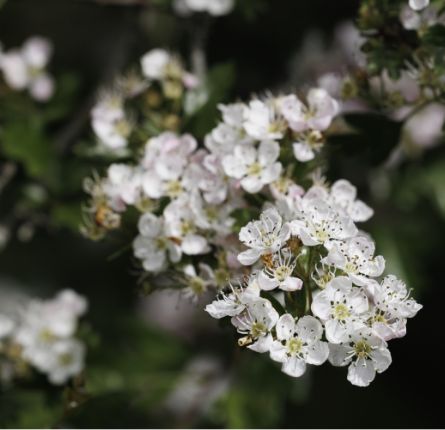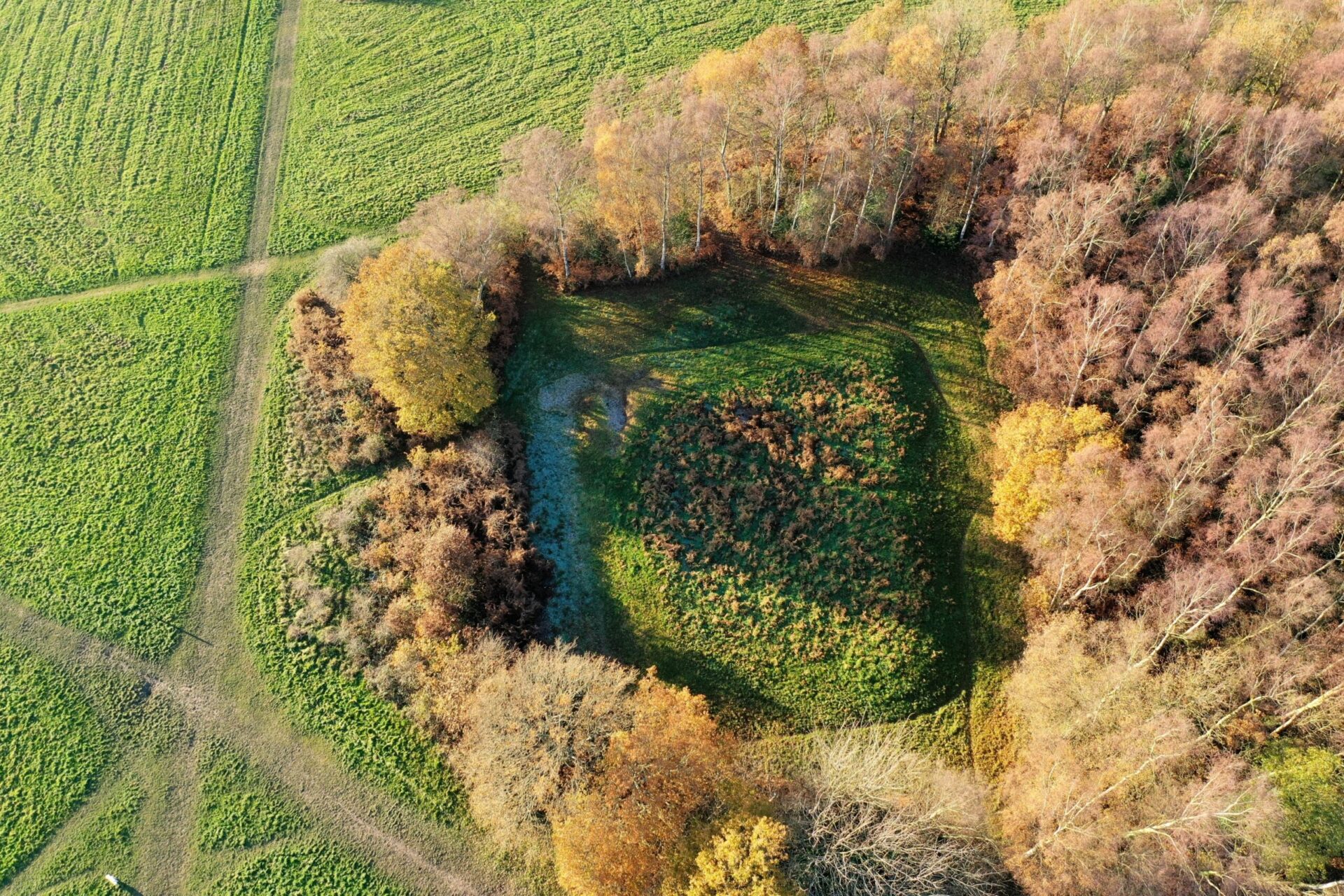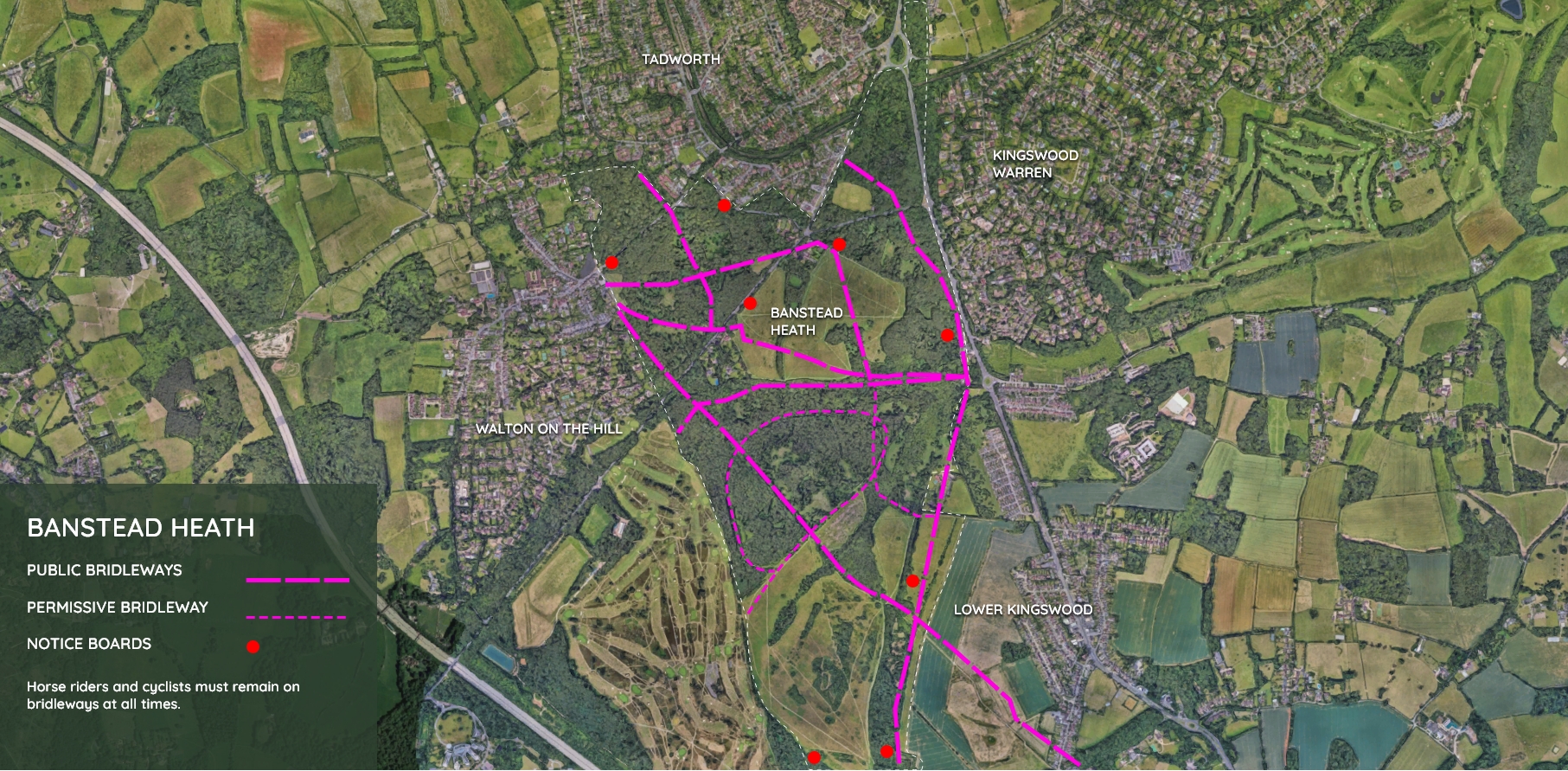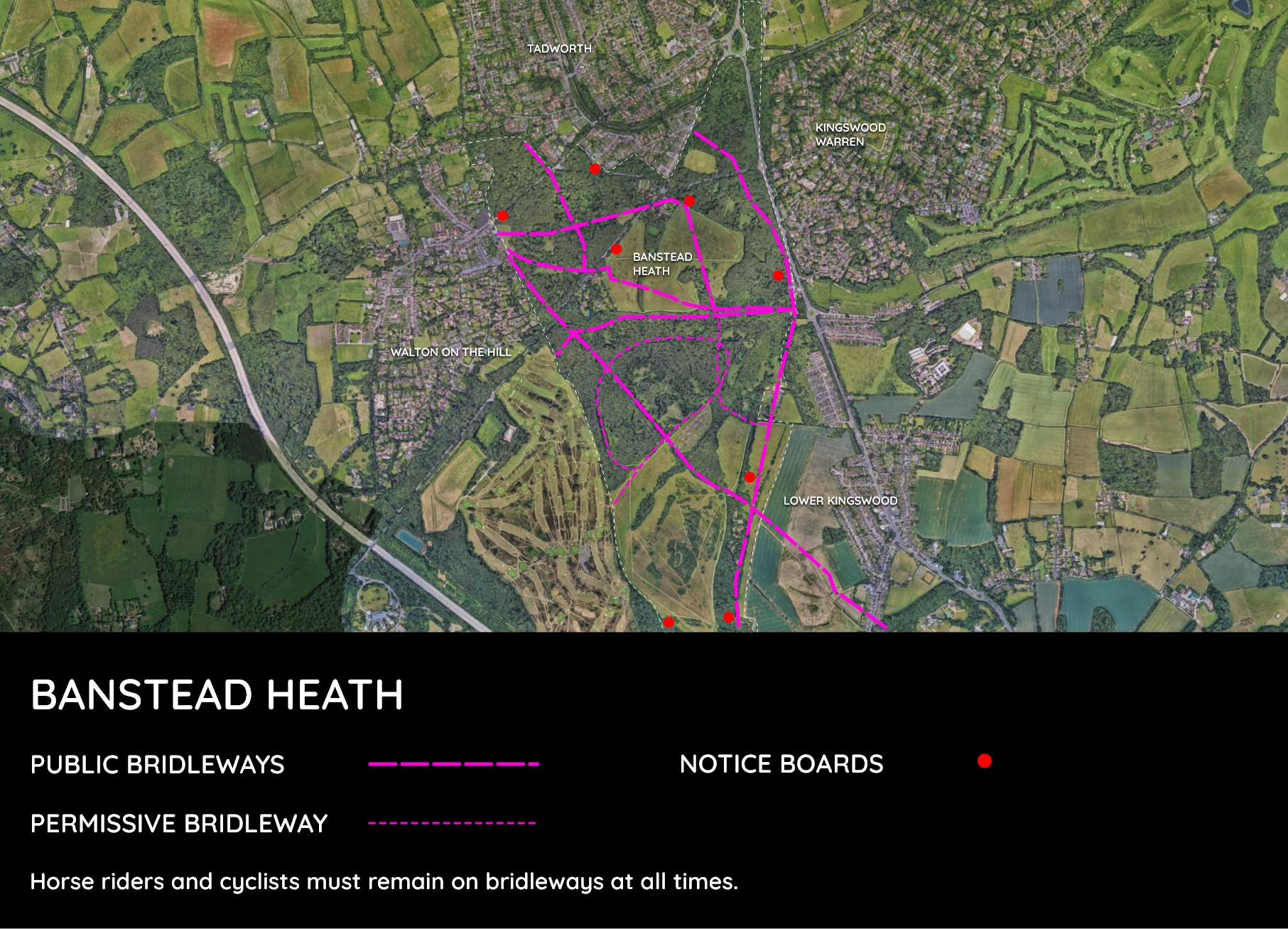Banstead Heath
Banstead Heath is the largest of our four sites and perhaps the most varied. The site is designated a Site of Nature Conservation Importance (SNCI) and boasts a mosaic of different habitats. The landscape is made up of traditional heath, acid grassland meadows and pockets of secondary woodland. It is a true jewel of the borough at all times of the year.
At 760 acres, Banstead Heath is very popular with all users, particularly walkers, cyclists and horse riders. With several stables adjoining or close by, there are more than eight miles of bridle paths and permissive rides on the Heath for riders to explore.
Download Site Map
Habitats
Banstead Heath is a mosaic of habitats, including secondary woodland, heath and open meadows.
The woodland trees are mostly oak and birch, often with a holly and hawthorn understorey, and there are a few scattered yews and non-native conifers, but look out for some rarer species such as whitebeam, wayfaring tree, aspen and rowan among others.
Three types of heather can be found in the more open areas as well as common heathland plants as gorse and broom. The meadows support many familiar grassland species, as well as some rarities, but the mainly acid soils mean orchids are few and far between.
For such a large area, Banstead Heath remains surprisingly poorly surveyed and, as a result, we believe that many resident species of both flora and fauna have been under-recorded, so we welcome reports from visitors.
The Heath has a long history of exploitation by man and all the disturbance and modification associated with that.
One of the main aims of the current management plan of Banstead Heath is to restore and enhance the full range of historical habitats. That includes encouragement of the mixed lowland heath that we would expect to occur on this type of soil. This habitat has dramatically declined in recent times and is under threat across the South East.

Flora
The most recent scientific survey of the Heath's flora dates from July 1994. Almost 200 species of flowering plant were identified then and we hope to update the list soon.
Some of the most obvious flowers that you will see are the various species of hawkweed, hawkbit and hawk's-beard that flower prolifically amongst the meadow grasses during the warmer months. They look a bit like long-stalked dandelions with flowers ranging from pale lemon yellow to deep orange and can be quite a challenge to differentiate, even for experts. You will also see purple knapweed, lilac scabious, pink or red willowherbs and yellow tormentil, among others.
At the southern end of the Heath there are large areas of mixed heather that provide a colourful display in late summer. Many species of fungi can be found, especially in the autumn months but they, as well as interesting mosses, lichens and liverworts, can be seen all year round if you look closely.
Although Bracken is a dominant species in many areas of the Heath, active measures are being taken to reduce its smothering effect and allow more light and air in to encourage the growth of less resilient plants.

Fauna
The most obvious animals on the Heath are the birds but there are many mammals too and it is also a vital haven for some of our vulnerable reptiles, amphibians and invertebrates.
Of the birds, you cannot fail to be aware during most of the year of the presence of skylarks. These are a nationally threatened species with special legal protections. They breed in reasonably healthy numbers in the grassy meadows, especially Mill Field. Thanks to the Conservators' best efforts to enforce their legal obligations, the skylark population appears to be increasing on the Heath.
The most recent surveys (1970 and 1990) of the breeding birds of Walton and Banstead Heaths suggested a continuing significant decline in the number of species present, although a range of heathland birds such as linnet and yellowhammer and some migrant warblers remain.
One indication that we were getting the habitat management right was that gorse-loving Dartford Warblers seemed to have established themselves. Unfortunately, they vanished again but the good news is that there have been some new sightings recently, so we hope they will return.
Other notable species include Nuthatches, Treecreepers and woodpeckers, particularly Green Woodpeckers, often seen hunting for insects on the ground. There are also several species of owl and other raptors. During May and June, Woodcock are frequently seen at dusk.
Mammals are well represented on the Heath including foxes, roe deer, badgers, moles, rabbits, shrews, mice, voles and bats. Perhaps surprisingly, no evidence for the presence of dormice has yet been found.
The Heath is particularly important for reptile species and one to look out for in the summer is the Adder which is relatively common on the Heath. This is a shy animal and is most likely to been seen basking in sunny clearings in the scrub or bracken. There are also Grass Snakes, Slowworms and Common Lizards.
Banstead Heath is notable for large numbers of butterflies in high summer. The Browns and Skippers are the dominant species but, as with other wildlife on the Heath, comprehensive information down to species level and their relative abundance has been lacking until recently. We have set up a number of regular surveys now that we hope will enhance our knowledge and understanding of how to preserve what we have and encourage even more diversity. One notable insect that was found on Banstead Heath is the Bog Bush Cricket but there will inevitably be more to reveal

Archaeology
No part of the English landscape is "natural". It has been exploited and manipulated by man ever since Ice Age glaciers, and the apocalyptic floods that followed their retreat, swept away most of what was here before. Some of the "archaeological" remains that surround us are very subtle and sometimes surprising. Almost imperceptible humps, bumps and ridges that can be seen on the Heath (but are largely invisible where houses have been built, roads laid, fields ploughed or timber grown) are actually ancient field, parish or tribal boundaries, evidence of old agricultural techniques, such as "ridge and furrow", or even burial sites. Even seemingly "natural" ponds are almost invariably man-made (to provide water for stock, grow fish, reed thatch or withies etc or attract wildfowl for the pot, for example). The landscape will never seem the same again once you start looking for all these little clues when you go for a walk!
Identifying some of the man-made points of interest on the Heath are not so challenging though. There are three medieval stock enclosures, built as resting places to corral stock and protect them from wild animals and rustlers during their long journey from their grazing areas to markets. There are coal tax posts that marked the boundary of the City of London's control of trade. There is the Roman Villa site at Chussex Plain. There are scattered remnants of Second World War activity, including trenches and shelters built by the Home Guard (Dad's Army!).
Map of Banstead Heath


